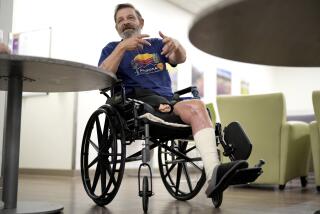Simple Rules for Not Getting Burned
- Share via
Whether her patients plan to mountain bike in Utah, beachcomb in Hawaii or sightsee in New York City, Santa Monica dermatologist Kathleen Adair offers the same advice as when they’re not traveling: Use sunscreen and cover up.
But that’s just the beginning. Travelers hoping to avoid painful sunburn and lower their risk of skin cancer must tailor preventive measures to their destinations. They must factor in altitude, latitude and the specific environment, boosting sun protection measures as needed, Adair and other experts say.
It may soon be easier for international travelers to assess sunburn risks around the world, as a standardized ultraviolet exposure index is phased in over the next year.
But whatever the destination, travelers are wise to increase the sun protection factor (SPF) of their sunscreen, said Adair, a USC assistant clinical professor of dermatology. “For the average person on an average day, 15 [SPF] is probably enough,” she said. “But for travelers I recommend using at least a 30.” Adair reasons that travelers, especially those on vacation, get involved in outdoor activities, stay out in the sun longer than they would at home and forget to reapply sunscreen often enough.
SPFs indicate a sunscreen’s effectiveness in preventing redness. For instance, if unprotected skin is the type that turns red in 30 minutes, using an SPF 15 sunscreen would theoretically protect it 15 times longer than 30 minutes. But many experts recommend reapplying sunscreen every two hours.
Sports formulas, promoted as waterproof and sweat proof, are considered a good choice for travelers, because they stay on better. For younger travelers, children’s formulas are designed to sting less and may be less irritating to the skin. (Sunscreen is not generally recommended for infants under 6 months.)
While growing numbers of products claim to block ultraviolet A radiation and ultraviolet B radiation, “the perfect sunscreen doesn’t exist,” Adair said. These broad-spectrum formulas have become more common as research suggests that UVB rays, long blamed for causing skin cancer, and UVA rays, long blamed for wrinkling, might both be culprits in promoting skin cancers. UVA and UVB radiation may, in fact, work together in promoting skin cancer, said Stephen Ullrich, who conducts research in the field and is an associate professor of immunology at the University of Texas-M.D. Anderson Medical Center, Houston.
Some sunscreens bear the recommendation seal of the Skin Cancer Foundation, an international nonprofit group based in New York. To earn the seal, manufacturers must submit products to the foundation for testing. Continued approval requires annual review.
Sunglasses are also recommended, because some studies indicate a relationship between ultraviolet exposure and cataract formation. “You can also cause damage to your retina in harsh sun,” Ullrich said.
Travelers vacationing at high altitudes or southern latitudes (including areas near the Equator) should be especially careful to cover up. “Ultraviolet levels increase 2% for every 1,000-foot increase in altitude,” said Drusilla Hufford, acting director of the stratospheric protection division of the U.S. Environmental Protection Agency. Ultraviolet exposure increases with altitude, she said, “because there is less atmosphere to attenuate the radiation.”
Travelers hoping to avoid sunburn should be extra vigilant when anywhere in southern latitudes, Ullrich said. If engaging in underwater activities, don’t assume exposures are reduced. “People who go snorkeling in places like Hawaii should know that UV penetrates down [several feet] into the water,” Ullrich said.
Calculating sunburn risk is becoming easier. The UV index, introduced by the National Weather Service and EPA in 1994 and now used in major U.S. cities, measures daily levels of exposure to UV radiation, Hufford said--reported as levels from 0 to 10-plus. Using the UV index and factoring in type of skin, a person can gauge how quickly they could burn. A sensitive-skinned person, for instance, could burn in fewer than five minutes on a level-10 day.
Currently, at least eight countries have a UV index, said Rumen Bojkov of the World Meteorological Organization, a Geneva-based agency of the United Nations. (They are: the United States, Finland, Denmark, Netherlands, Germany, Canada, Greece and Cuba.) However, the indexes do not all measure sunburn risk identically. “The World Meteorological Organization is trying to introduce a uniform UV index,” Bojkov said. “It will take another year” before it’s implemented. The U.S. index conforms to international standards.
If sunburn occurs despite preventive measures, “there’s not a lot you can do,” Adair said. Taking aspirin or acetaminophen may help, “but studies show it works better if you take it before. And who plans on getting a sunburn?”
Cold compresses soaked in vinegar and water may also relieve pain, she added. Travelers with severe sunburn should seek medical help. Drinking fluids is also advised, because sunburn promotes dehydration.
The Healthy Traveler appears the second and fourth week of every month.
More to Read
Sign up for The Wild
We’ll help you find the best places to hike, bike and run, as well as the perfect silent spots for meditation and yoga.
You may occasionally receive promotional content from the Los Angeles Times.






